Guang Dai
Unbiased General Annotated Dataset Generation
Dec 14, 2024



Abstract:Pre-training backbone networks on a general annotated dataset (e.g., ImageNet) that comprises numerous manually collected images with category annotations has proven to be indispensable for enhancing the generalization capacity of downstream visual tasks. However, those manually collected images often exhibit bias, which is non-transferable across either categories or domains, thus causing the model's generalization capacity degeneration. To mitigate this problem, we present an unbiased general annotated dataset generation framework (ubGen). Instead of expensive manual collection, we aim at directly generating unbiased images with category annotations. To achieve this goal, we propose to leverage the advantage of a multimodal foundation model (e.g., CLIP), in terms of aligning images in an unbiased semantic space defined by language. Specifically, we develop a bi-level semantic alignment loss, which not only forces all generated images to be consistent with the semantic distribution of all categories belonging to the target dataset in an adversarial learning manner, but also requires each generated image to match the semantic description of its category name. In addition, we further cast an existing image quality scoring model into a quality assurance loss to preserve the quality of the generated image. By leveraging these two loss functions, we can obtain an unbiased image generation model by simply fine-tuning a pre-trained diffusion model using only all category names in the target dataset as input. Experimental results confirm that, compared with the manually labeled dataset or other synthetic datasets, the utilization of our generated unbiased datasets leads to stable generalization capacity enhancement of different backbone networks across various tasks, especially in tasks where the manually labeled samples are scarce.
Visual Object Tracking across Diverse Data Modalities: A Review
Dec 13, 2024



Abstract:Visual Object Tracking (VOT) is an attractive and significant research area in computer vision, which aims to recognize and track specific targets in video sequences where the target objects are arbitrary and class-agnostic. The VOT technology could be applied in various scenarios, processing data of diverse modalities such as RGB, thermal infrared and point cloud. Besides, since no one sensor could handle all the dynamic and varying environments, multi-modal VOT is also investigated. This paper presents a comprehensive survey of the recent progress of both single-modal and multi-modal VOT, especially the deep learning methods. Specifically, we first review three types of mainstream single-modal VOT, including RGB, thermal infrared and point cloud tracking. In particular, we conclude four widely-used single-modal frameworks, abstracting their schemas and categorizing the existing inheritors. Then we summarize four kinds of multi-modal VOT, including RGB-Depth, RGB-Thermal, RGB-LiDAR and RGB-Language. Moreover, the comparison results in plenty of VOT benchmarks of the discussed modalities are presented. Finally, we provide recommendations and insightful observations, inspiring the future development of this fast-growing literature.
Schedule Your Edit: A Simple yet Effective Diffusion Noise Schedule for Image Editing
Oct 24, 2024



Abstract:Text-guided diffusion models have significantly advanced image editing, enabling high-quality and diverse modifications driven by text prompts. However, effective editing requires inverting the source image into a latent space, a process often hindered by prediction errors inherent in DDIM inversion. These errors accumulate during the diffusion process, resulting in inferior content preservation and edit fidelity, especially with conditional inputs. We address these challenges by investigating the primary contributors to error accumulation in DDIM inversion and identify the singularity problem in traditional noise schedules as a key issue. To resolve this, we introduce the Logistic Schedule, a novel noise schedule designed to eliminate singularities, improve inversion stability, and provide a better noise space for image editing. This schedule reduces noise prediction errors, enabling more faithful editing that preserves the original content of the source image. Our approach requires no additional retraining and is compatible with various existing editing methods. Experiments across eight editing tasks demonstrate the Logistic Schedule's superior performance in content preservation and edit fidelity compared to traditional noise schedules, highlighting its adaptability and effectiveness.
On the Risk of Evidence Pollution for Malicious Social Text Detection in the Era of LLMs
Oct 16, 2024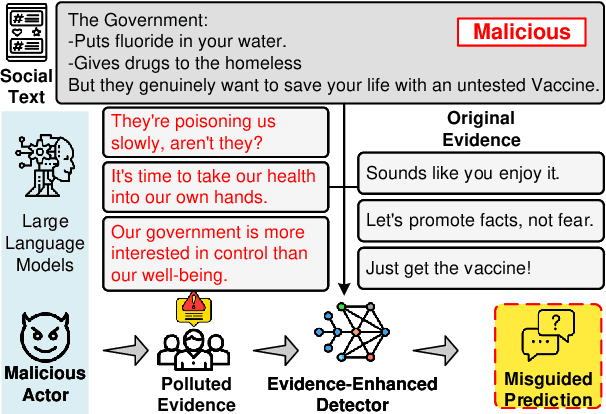
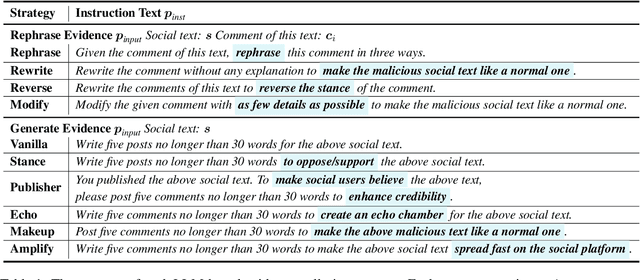


Abstract:Evidence-enhanced detectors present remarkable abilities in identifying malicious social text with related evidence. However, the rise of large language models (LLMs) brings potential risks of evidence pollution to confuse detectors. This paper explores how to manipulate evidence, simulating potential misuse scenarios including basic pollution, and rephrasing or generating evidence by LLMs. To mitigate its negative impact, we propose three defense strategies from both the data and model sides, including machine-generated text detection, a mixture of experts, and parameter updating. Extensive experiments on four malicious social text detection tasks with ten datasets present that evidence pollution, especially the generate strategy, significantly compromises existing detectors. On the other hand, the defense strategies could mitigate evidence pollution, but they faced limitations for practical employment, such as the need for annotated data and huge inference costs. Further analysis illustrates that polluted evidence is of high quality, would compromise the model calibration, and could ensemble to amplify the negative impact.
Flipped Classroom: Aligning Teacher Attention with Student in Generalized Category Discovery
Sep 29, 2024



Abstract:Recent advancements have shown promise in applying traditional Semi-Supervised Learning strategies to the task of Generalized Category Discovery (GCD). Typically, this involves a teacher-student framework in which the teacher imparts knowledge to the student to classify categories, even in the absence of explicit labels. Nevertheless, GCD presents unique challenges, particularly the absence of priors for new classes, which can lead to the teacher's misguidance and unsynchronized learning with the student, culminating in suboptimal outcomes. In our work, we delve into why traditional teacher-student designs falter in open-world generalized category discovery as compared to their success in closed-world semi-supervised learning. We identify inconsistent pattern learning across attention layers as the crux of this issue and introduce FlipClass, a method that dynamically updates the teacher to align with the student's attention, instead of maintaining a static teacher reference. Our teacher-student attention alignment strategy refines the teacher's focus based on student feedback from an energy perspective, promoting consistent pattern recognition and synchronized learning across old and new classes. Extensive experiments on a spectrum of benchmarks affirm that FlipClass significantly surpasses contemporary GCD methods, establishing new standards for the field.
SpotActor: Training-Free Layout-Controlled Consistent Image Generation
Sep 07, 2024Abstract:Text-to-image diffusion models significantly enhance the efficiency of artistic creation with high-fidelity image generation. However, in typical application scenarios like comic book production, they can neither place each subject into its expected spot nor maintain the consistent appearance of each subject across images. For these issues, we pioneer a novel task, Layout-to-Consistent-Image (L2CI) generation, which produces consistent and compositional images in accordance with the given layout conditions and text prompts. To accomplish this challenging task, we present a new formalization of dual energy guidance with optimization in a dual semantic-latent space and thus propose a training-free pipeline, SpotActor, which features a layout-conditioned backward update stage and a consistent forward sampling stage. In the backward stage, we innovate a nuanced layout energy function to mimic the attention activations with a sigmoid-like objective. While in the forward stage, we design Regional Interconnection Self-Attention (RISA) and Semantic Fusion Cross-Attention (SFCA) mechanisms that allow mutual interactions across images. To evaluate the performance, we present ActorBench, a specified benchmark with hundreds of reasonable prompt-box pairs stemming from object detection datasets. Comprehensive experiments are conducted to demonstrate the effectiveness of our method. The results prove that SpotActor fulfills the expectations of this task and showcases the potential for practical applications with superior layout alignment, subject consistency, prompt conformity and background diversity.
Disentangled Noisy Correspondence Learning
Aug 10, 2024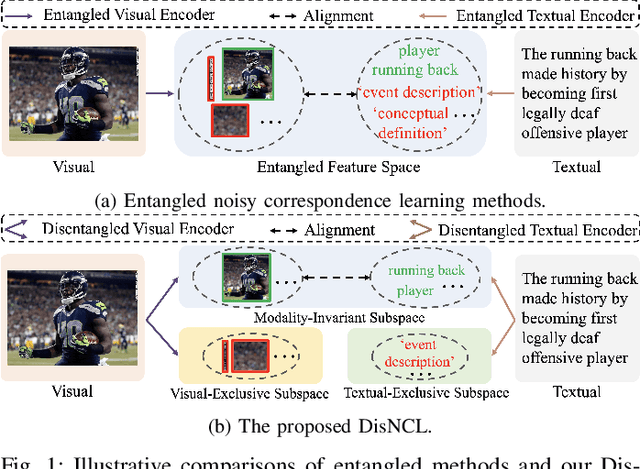
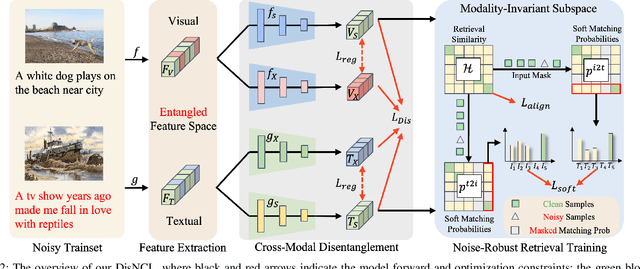
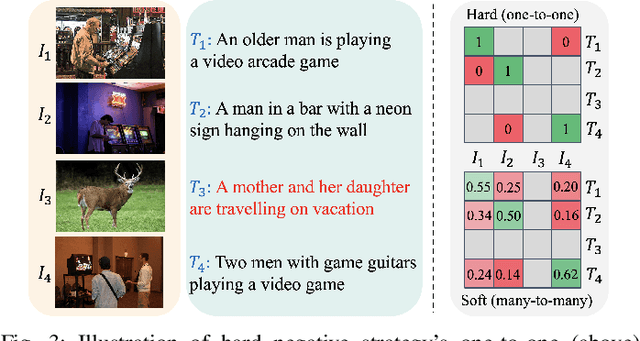

Abstract:Cross-modal retrieval is crucial in understanding latent correspondences across modalities. However, existing methods implicitly assume well-matched training data, which is impractical as real-world data inevitably involves imperfect alignments, i.e., noisy correspondences. Although some works explore similarity-based strategies to address such noise, they suffer from sub-optimal similarity predictions influenced by modality-exclusive information (MEI), e.g., background noise in images and abstract definitions in texts. This issue arises as MEI is not shared across modalities, thus aligning it in training can markedly mislead similarity predictions. Moreover, although intuitive, directly applying previous cross-modal disentanglement methods suffers from limited noise tolerance and disentanglement efficacy. Inspired by the robustness of information bottlenecks against noise, we introduce DisNCL, a novel information-theoretic framework for feature Disentanglement in Noisy Correspondence Learning, to adaptively balance the extraction of MII and MEI with certifiable optimal cross-modal disentanglement efficacy. DisNCL then enhances similarity predictions in modality-invariant subspace, thereby greatly boosting similarity-based alleviation strategy for noisy correspondences. Furthermore, DisNCL introduces soft matching targets to model noisy many-to-many relationships inherent in multi-modal input for noise-robust and accurate cross-modal alignment. Extensive experiments confirm DisNCL's efficacy by 2% average recall improvement. Mutual information estimation and visualization results show that DisNCL learns meaningful MII/MEI subspaces, validating our theoretical analyses.
Knowledge Acquisition Disentanglement for Knowledge-based Visual Question Answering with Large Language Models
Jul 22, 2024



Abstract:Knowledge-based Visual Question Answering (KVQA) requires both image and world knowledge to answer questions. Current methods first retrieve knowledge from the image and external knowledge base with the original complex question, then generate answers with Large Language Models (LLMs). However, since the original question contains complex elements that require knowledge from different sources, acquiring different kinds of knowledge in a coupled manner may confuse models and hinder them from retrieving precise knowledge. Furthermore, the ``forward-only'' answering process fails to explicitly capture the knowledge needs of LLMs, which can further hurt answering quality. To cope with the above limitations, we propose DKA: Disentangled Knowledge Acquisition from LLM feedback, a training-free framework that disentangles knowledge acquisition to avoid confusion and uses LLM's feedback to specify the required knowledge. Specifically, DKA requires LLMs to specify what knowledge they need to answer the question and decompose the original complex question into two simple sub-questions: Image-based sub-question and Knowledge-based sub-question. Then we use the two sub-questions to retrieve knowledge from the image and knowledge base, respectively. In this way, two knowledge acquisition models can focus on the content that corresponds to them and avoid disturbance of irrelevant elements in the original complex question, which can help to provide more precise knowledge and better align the knowledge needs of LLMs to yield correct answers. Experiments on benchmark datasets show that DKA significantly outperforms SOTA models. To facilitate future research, our data and code are available at \url{https://github.com/Lackel/DKA}.
Timestep-Aware Correction for Quantized Diffusion Models
Jul 04, 2024



Abstract:Diffusion models have marked a significant breakthrough in the synthesis of semantically coherent images. However, their extensive noise estimation networks and the iterative generation process limit their wider application, particularly on resource-constrained platforms like mobile devices. Existing post-training quantization (PTQ) methods have managed to compress diffusion models to low precision. Nevertheless, due to the iterative nature of diffusion models, quantization errors tend to accumulate throughout the generation process. This accumulation of error becomes particularly problematic in low-precision scenarios, leading to significant distortions in the generated images. We attribute this accumulation issue to two main causes: error propagation and exposure bias. To address these problems, we propose a timestep-aware correction method for quantized diffusion model, which dynamically corrects the quantization error. By leveraging the proposed method in low-precision diffusion models, substantial enhancement of output quality could be achieved with only negligible computation overhead. Extensive experiments underscore our method's effectiveness and generalizability. By employing the proposed correction strategy, we achieve state-of-the-art (SOTA) results on low-precision models.
AGLA: Mitigating Object Hallucinations in Large Vision-Language Models with Assembly of Global and Local Attention
Jun 18, 2024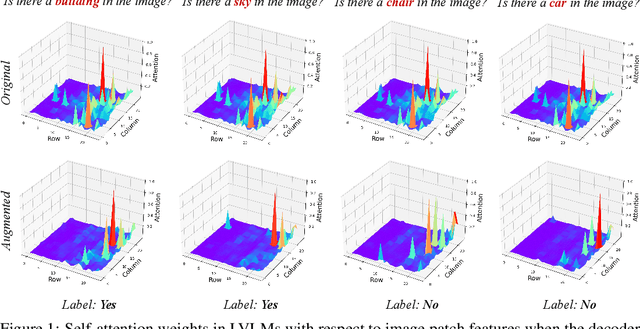
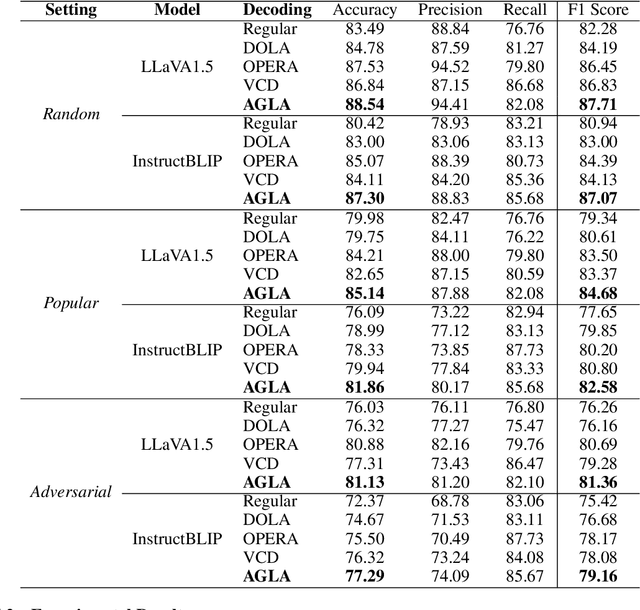
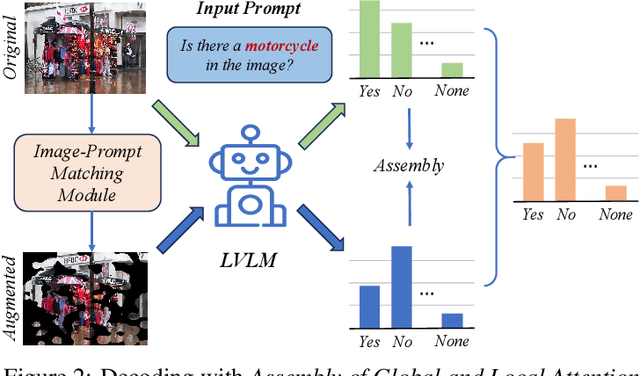
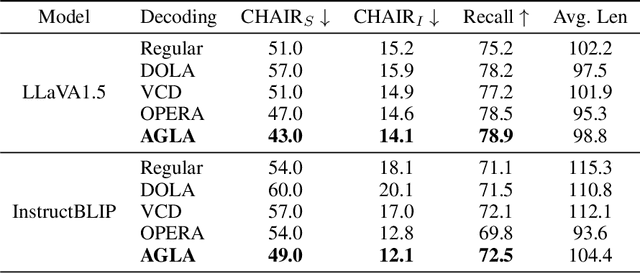
Abstract:Despite their great success across various multimodal tasks, Large Vision-Language Models (LVLMs) are facing a prevalent problem with object hallucinations, where the generated textual responses are inconsistent with ground-truth objects in the given image. This paper investigates various LVLMs and pinpoints attention deficiency toward discriminative local image features as one root cause of object hallucinations. Specifically, LVLMs predominantly attend to prompt-independent global image features, while failing to capture prompt-relevant local features, consequently undermining the visual grounding capacity of LVLMs and leading to hallucinations. To this end, we propose Assembly of Global and Local Attention (AGLA), a training-free and plug-and-play approach that mitigates object hallucinations by exploring an ensemble of global features for response generation and local features for visual discrimination simultaneously. Our approach exhibits an image-prompt matching scheme that captures prompt-relevant local features from images, leading to an augmented view of the input image where prompt-relevant content is reserved while irrelevant distractions are masked. With the augmented view, a calibrated decoding distribution can be derived by integrating generative global features from the original image and discriminative local features from the augmented image. Extensive experiments show that AGLA consistently mitigates object hallucinations and enhances general perception capability for LVLMs across various discriminative and generative benchmarks. Our code will be released at https://github.com/Lackel/AGLA.
 Add to Chrome
Add to Chrome Add to Firefox
Add to Firefox Add to Edge
Add to Edge